#EnermaxAIOcoolers
Explore tagged Tumblr posts
Text
Enermax Liqtech II 360 Review
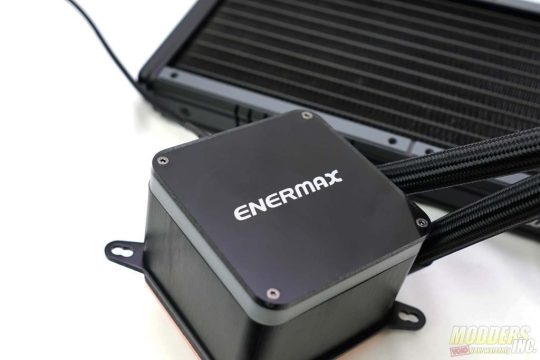
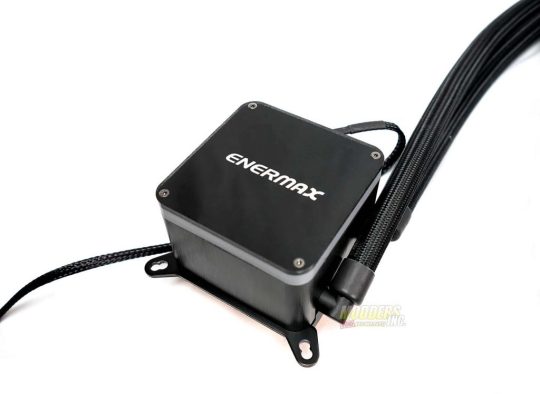
With the ever increasing core count and TDP of mainstream processors these days, cooling has never been more important to your system. Although there are some seriously beefy air coolers on the market today, liquid cooling is still the best way to cool your system. That being said, even with most companies offering some kind of full loop kits, custom water cooling can still be intimidating to many enthusiasts. So, for a lot of people, an AIO, or all in one cooler is the way to go. Enermax is perhaps one of the best-known names is in computer hardware. Having been in business since the early 1990s, they make everything from computer cases and fans to power supplies and peripherals. However, one of the things Enermax is best known for is coolers, and AIO coolers to be specific. Enermax has always held a special place in my heart. The first published review I ever wrote was of the Lepa Exllusion 240. Overall, I’ve had rather good luck with their products in general. So, when they asked if we’d take a look at their new Liqtech II 360, we couldn’t say no. The Enermax Liqtech II 360 is a 360 mm AIO cooler with an insane 500 watt TDP. The Liqtech II is compatible with both Intel and AMD sockets. Its EF1 pump is said to be seven times more powerful than the average AIO and move up to 450 liters per hour. Now, that’s all well and good, if it lives up to its expectations. Many times, in the past I’ve tested AIO coolers that just couldn’t handle a high core count processor. So, we put the Liqtech II through its paces on the Intel Core i7 8700k. So, did it live up to its claims? Let’s find out.

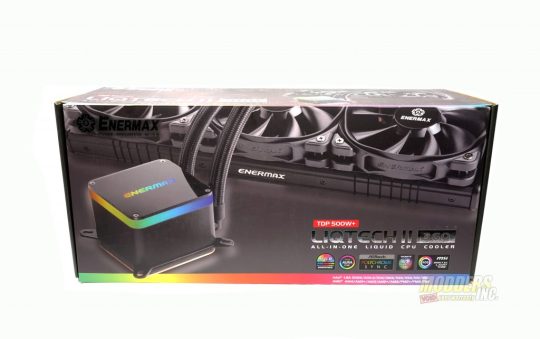
The Front of the packaging has an image of the block and pump combo, with the RGB lighting illuminated in the foreground. In the background, there is an image of the 360 mm radiator with the three 120mm fans installed. Printed on the bottom right corner is the Liqtech II 360 branding, Below that are badges for the several different RGB software that the Liqtech II supports.
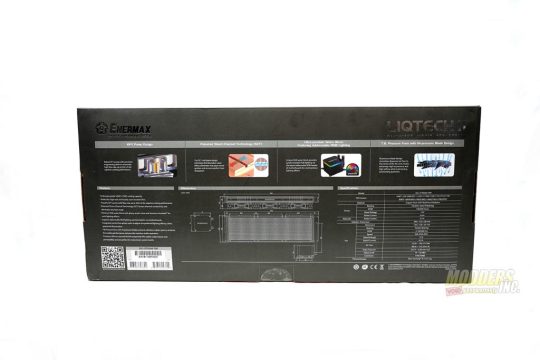
The back of the box has a lot of information on the Liqtech II. Across the top, they touch on some of the key features of the Liqtech II 360. Enermax also has a complete list of features listed to the left. Next, there is a diagram of the length, width, and height of both the pump and radiator. There is also a chart with the specifications of the Liqtech II to the far right.
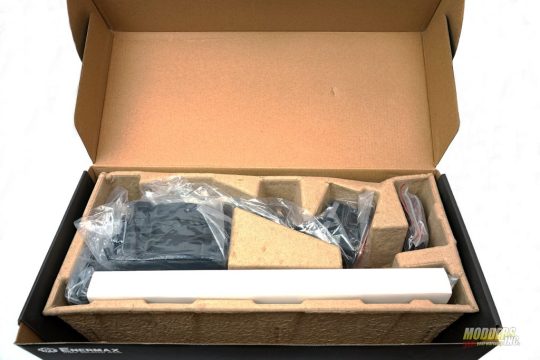
The Enermax Liqtech II comes packed is a formed cardboard tray. The cooler and fans are wrapped in plastic. The radiator has a protective sleeve over it to provide extra protection. Although I do prefer this style of packaging over traditional styrofoam, I’d rather it be backed in soft foam. But that isn’t really that big of a deal. A Closer Look at the Liqtech II 360

The Enermax Liqtech II 360 looks much like any other 360 mm all-in-one, or AIO cooler. However, Enermax is advertising a monster 500 watt TDP for the Liqtech II 360. It supports both Intel and AMD modern sockets, with the exception of AMD's TR4 socket. Enermax makes a specific model for the TR4 socket.
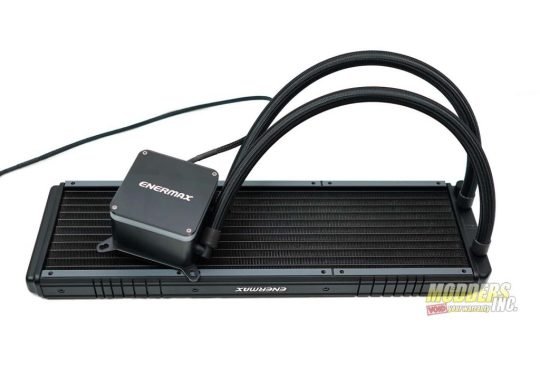
The radiator for the cooler measured 394 mm long x 120 mm wide x 28 mm in thickness. The Liqtech II 360 supports three 120 mm fans. It comes packed with three static pressure fans. The fans measure 120 x 120 x 25 mm. The fans have a high-pressure blade design that increases cooling performance. The fans come equipped with anti-vibration rubber pads in the corners to prevent noise and ensure noiseless operation. The block and pump combo measure 71 mm in length, 71 mm in width and 60 mm in height. The actual cold plate is 56 mm in both length and width and 3 mm thick, at its thickest point. The cold plate on the Enermax Liqtech II uses their patented shunt-channel-technology (SCT). The shunt-channel-technology is designed to boost thermal conductivity and eliminates heat surge by increasing coolant flow. The SCT allows heated and non-heated coolant to swap channels and increase utilization rates. The Liqtech II features a powerful EF1 pump design with flow rates up to 450 liters per hour. The EF1 pump, on average, moves seven times more fluid than the average AIO pump. The average AIO cooler moves about 65 liters per hour. The EF1 pump delivers a very high flow rate, designed to increase cooling performance.

The Enermax Liqtech II uses flexible, 400 mm polyamide rubber tubing. The rubber tubing has a layer of flexible polyamide weaved through the tubing. A polyamide is a synthetic polymer, the most common of which is nylon. The polyamide layer ensures the tubing is impermeable. The tubing is covered by nylon sleeving. This makes the cooler more aesthetically pleasing. Installation of the Enermax Liqtech II 360 was rather straight forward. The Liqtech II 360 comes with a universal backplate. One side is for modern Intel sockets and the other for modern AMD sockets. First, push the pins through the proper holes for your socket. In the case of this review, it was the LGA 1151 socket. Next step, you use the plastic washers to hold the backplate to the motherboard. The Liqtech II 360 comes with nuts with springs attached. This is what is used to affix the block to the motherboard. A Philips head screwdriver is then used to tighten them down. The Liqtech II features an Aurabelt waterblock with addressable RGB lighting. The lighting can be controlled by your motherboard and is supported by all major RGB software from the board partners. This includes RGB Fusion, Mystic Light and Aura Sync. However, Enermax also includes an in-line RGB controller as-well. This is useful if you have an older motherboard, without RGB headers. There is a 4-pin connection on the same side of the pump that the PWM connector come out of. This 4-pin connector connects the RGB lighting on the pump to either an RGB header on your motherboard or to the in-line RGB controller that comes packed with the Enermax Liqtech II 360. One of my favorite accessories that come packed with the Enermax Liqtech II 360 is the 3-way PWM fan splitter. This allows you to only use one fan header on your motherboard for the 3 fans packed with the Liqtech II 360 Test System, Testing Procedure and Performance.
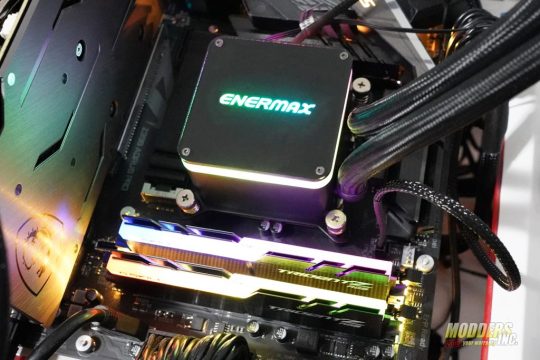
Test System Component Product Name Provided By Processor Intel Core i7-8700K (Retail) Intel Motherboard Aorus Z390 Pro Gigabyte Memory G.Skill Trident Z DDR4 3200 MHz CAS 14 64 GB G.Skill Drive Intel 660p 512 GB NVMe M.2 SSD (OS) Intel Video Card MSI Gaming X Trio 2080 ti Cutting Edge Gamer Monitor LG 27UL500-W 27" 3840×2160 @ 60 Hz Retail Purchase Case Primochill Praxis Wetbench Primochill Power Supply 1600 Watt EVGA Super Nova Ps 80+ Platinum Power Supply EVGA Operating System Windows 10 x64 Pro with latest patches and updates Utilities and Software CPUID Hardware Monitor CPUID CPU-Z AIDA64 Engineer Cinebench R15 Sound Meter (Android App) All testing on the Enermax Liqtech II 360 was done on the Core I7 8700k. The I7 8700k has a base clock of 3.7 GHz. However, from stock, it usually boosts to about 4.3 GHz. I increased the overclock to 4.5 GHz and left the voltage at stock. This seemed to be a reasonable overclock, that just about anyone should be able to achieve with an 8700k. In the past, I've gotten this 8700k to 4.8ghz, but not much higher. I tried to set the CPU to 4.8 GHz, and the system crashed instantly. At 4.7 GHz, the system ran. It was fine on light tasks. However, when I attempted to run the Aida64 FPU stability test, the processor hit 100°c in a matter of seconds and the system crashed. I do my best to keep the ambient temperature around 20°c, or 68°f. Once the ambient temperature hits 21°c (about 70°f), I stop to allow the room to cool down a bit. There are no less than 30 minutes between each benchmark, and or program. This allows the processor to cool down and it gives more fair and balanced results. Although there are several different options to use while testing a CPU cooler, we use the AIDA64 Stress Test to put a load on the CPU. The AIDA 64 Stress Test is a 64-bit, multithreaded stress test. We use both the CPU stress test, as well as the FPU stress test. The FPU tests put far more of a strain on your processor. Therefore, the FPU test produces more heat than the CPU test. You could have a rock solid overclock that passes the CPU stress test but fails miserably on the FPU test. The chart below reflects the package temperature.
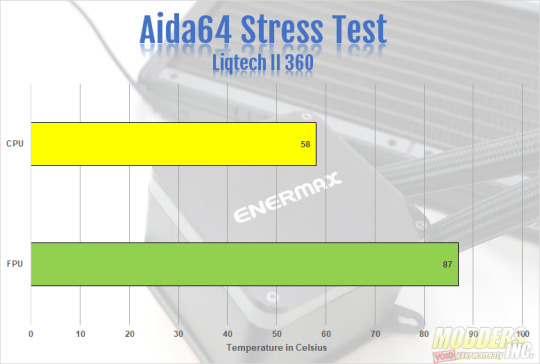
While running the AIDA64 CPU Stress Test, the temperatures were not that bad. Both the CPU test was run until the temperature for about 15 minutes in total. This is the target time for each of the tests to be deemed successful in my eyes. The AIDA64 CPU stress test hit a max temp of 58°c. During the CPU stress test, we recorded no throttling. As stated before, the AIDA64 FPU Stress Test put a far greater strain on your processor. Therefore, there wasn’t too much of a surprise to see the CPU throttle a bit. By the AIDA FPU stress test, the 8700k throttled about 3%. This test also ran for about 15 minutes. In that time, it hit a max temperature of 87°c. This isn’t by any means the lowest temperature but considering the load, the FPU stress test puts on your processor, its not terrible either. Our 8700k passed the Aida64 CPU stress test with no problems. The FPU test was a bit different. Although the system didn't crash, our 8700k did throttle a bit. It may have made it to 15 minutes. However, due to the 8700k throttling, we have to consider the FPU test a failure. The cooler that is usually on my test bench is the Swiftech H320 X2 Prestige, slightly modified of course. The H320 X2 Prestige edition comes with Swiftech compression fittings and 5/8 flexible tubing. However, Like with most AIO coolers, the tubing isn't long enough to install the H320 x2 on the Praxis Wet Bench. So, I replaced the tubing. I also replaced the Apogee block that comes stock with an Ek Supremacy EVO. So keep that in mind. The last thing is the H320 X2 is using Mayhems X1 Clear coolant. So, it does have several unfair advantages.

That being said, the differences were vast. During the Aida64 CPU stability test, our 8700k running at 4.5 GHz, hit a max temp of 53°c. This was 5°c than the Liqtech II 360 hit. The FPU stability test had an even larger difference. The 8700k hit a max temp of 74°c during the Aida64 FPU stability test. This is a full 13°c lower than the Liqtech II was able to achieve. Again, keep in mind there were some modifications made to the H320 X2. While gaming, both the noise levels and temperatures weren’t bad. When the temperature would get too high, the fans would ramp up to lower the temp. While playing Far Cry 5, the average temperature would hover around 65°c and max out at about 74°c. For comparison, the cooler on my test bench is usually the Swiftech H320 X2 prestige. Its also been modified with an Ek Supremacy Evo in place of the original Apogee block it came with. While playing Far Cry 5 for about the same time, 30 minutes or so, the 8700k hit a max temperature of 68°c and averaged around 60°c We also tested noise levels of the cooler using an Android app called Sound Meter. I know its not the best way to measure sound, but it’s the highest rated sound meter app on the app store and can at least give an idea of the noise levels. We recorded the noise levels with both the pump and fan speeds at 50% as well as 100%. At 50%, the system overall had an average decibel level of 37.7 dB and a max level of 42.6 dB. At 100%, it was loud, at times, and distracting. But the fans do not run 100% all the time. But when the temp rises, the fans will ramp up to 100% and that’s when the system gets loud. At 100%, the system ran at an average of 74.5 dB with a max of 83.4 dB. Now, keep in mind that this is on an open test bench and will not reflect noise levels in a closed system. Especially a case with sound dampening material. Not to mention, we don’t know how accurate the app we use is. We mention what app we used so users can compare their results to ours.

As we mentioned earlier, all testing was done with the pump and fan speeds at 100%. The stock setting was the fan and pump speed set to 50% speed. It was whisper quiet. However, it affected temperatures. The chart below represents initial temperatures taken about 20 minutes or so after the system was initially booted, first thing in the morning, on separate days. At 50% speed for both pump and fans, the max temp hit 53°c and the minimum was 43°c. The average was about 44°c at idle. When we tried to run the AIDA64 FPU stress test, after about 6 or 7 minutes, the temp hit 100°c. That is the reason all testing was done at 100% fan and pump speed. At 100%, the max temp hit only 45°c, 8° cooler than at 50%. The minimum temperature hit only 31°c and averaged about 34°c at idle. That gave us, at average, a difference of about 10°c between 50% and 100% pump and fans speed.
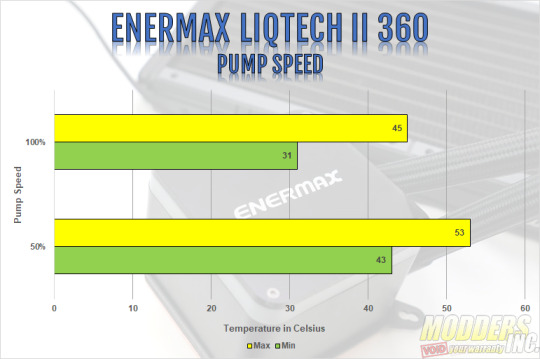
Final Thoughts and Conclusion I’ll start by saying that first and foremost, I prefer custom water cooling. So, my opinion is a bit bias. There are many AIO coolers in the market. Most of which perform similarly. For the most part, aesthetics will hold a large part in the decision making process. Personally, I love how the Liqtech II looks. I've said on several occasions that I am not a fan of RGB lighting. Although, it has started to grow on me when it is done right. I feel Enermax did the RGB lighting very well on the Liqtech II 360. I like the Aurabelt waterblock. The RGB lighting is subtle, and not overdone. That being said, I do think the Liqtech II could have benefited from using some kind of RGB fans on the Liqtech II. I know I just said I don't care for RGB lighting. However, when the pump has RGB lighting, most would assume the fans would as well. Given the static pressure fans packed with the Liqtech II did a relatively good job, even if they did get a bit loud at times.

The performance overall was pretty good with the Liqtech II 360. At times, the temps did seem a bit high. However, increasing the pump and fans speed rectified that. That being said, the system did get a bit loud when the fan speeds were increased. I will say again and can’t stress enough that I was using an open-air test bench. So, in a closed system, the Liqtech II 360 will be quieter. The temperature on the AIDA64 CPU stress test of 58°c wasn't bad at all. Although the FPU stress test in AIDA64 did result in the 8700k throttling, it was after more than 10 minutes and the FPU stress test was able to get through the 15 minutes we were aiming for. While gaming the temperatures were about average for an AIO cooler. The results were nothing spectacular, but they weren't causing performance issues and CPU throttling by any means. Enermax is advertising the Liqtech II 360 to have a TPD of 500 watts. But, it had trouble with the 8700k, with a slight overclock. The 8700k is a 95-watt processor. So I'm not sure how well it would do on a processor with say a 140 watt TDP. In conclusion The Enermax Liqtech II 360 is a decent cooler. However, if you’re an enthusiast and love to overclock, then this cooler isn’t for you. Nor was it meant for you either. The Enermax Liqtech II is a great option for the average gamer or consumer that wants something more than air cooling. Many 360 MM AIO coolers from other companies are upwards of $200 USD with the average price seeming to be about $180 USD. At the time of this review, The Enermax Liqtech II 360 is on Amazon for $159.99 USD. However, I have seen it as low as $139.99 in recent weeks on other online retailers. If you buy the Liqtech II 360 with intentions of pushing your processor as far as possible, you may be disappointed. However, if your intent to set up your system simply to play games, browse the web and other things the average consumer does with their PC, the Enermax Liqtech II 360 is a solid option. Especially when you compare the price to other 360 mm AIO coolers on the market. Read the full article
#360mmAIOcoolers#AIOCoolers#AllInOneCPUCooler#Enermax#EnermaxAIOcoolers#EnermaxLiqtechII360#LiqtechII360#modders-inc
0 notes